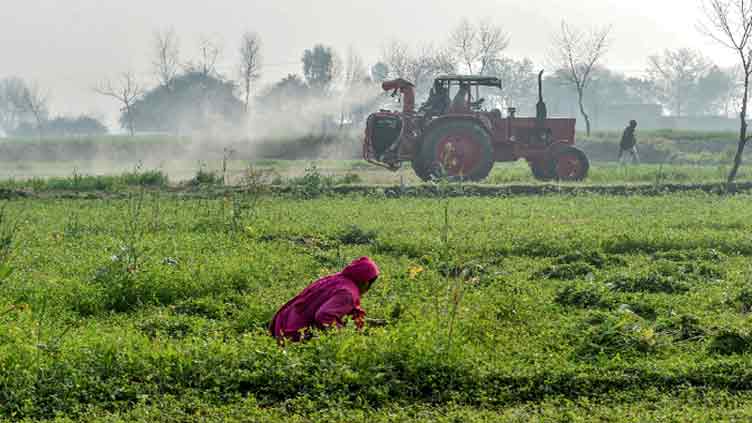Pakistan fourth most vulnerable country as El Nino threatens emerging economies

Business
Effects ranges from reduced agri production to even more higher food inflation
LONDON (Web Desk/Reuters) – Pakistan is fourth most vulnerable country to El Nino’s impact this year, according to the Standard Chartered Bank, as the South Asian nation is already battling with the effects of the last year’s devastating floods and erratic rains amid a record-high inflation and severe financial crunch.
It is an alarming scenario with the possibility of extreme weather further fuelling food inflation and food insecurity at a time when the people are already dealing with rising prices of petroleum products, gas and electricity.
Read more: Extreme weather events in Pakistan: WMO says climate change effects rising in Asia
In a latest report, Reuters says countries around the world are battling heatwaves and floods fuelled by El Nino, a naturally occurring climate phenomenon that has a 90 per cent probability of persisting in the second half of 2023, according to the World Meteorological Organization.
The worldwide impact can be enormous, but the stakes are higher for emerging markets, which are more exposed to swings in food and energy prices and production and often have smaller fiscal buffers that limit their ability to cushion the impact.
Following are the impacts El Nino - when waters in the central and eastern Pacific are warmer than usual - could have on key emerging markets.
1/MOST VULNERABLE
India and Egypt are among the economies that are overall most vulnerable to El Nino's impact this year, according to an index by Standard Chartered Bank, taking into account the weight of the primary sector, the share of food in inflation baskets and a country's ability to offset through fiscal support.
Apart from Pakistan, countries like Ghana, Kenya and the Philippines are also high up on the list while countries such as South Africa and Chile are among the least vulnerable - together with most of the developed market economies such as Germany or the United States.
"We believe that the countries most at risk from an El Nino event this year are those that have relatively weak economic fundamentals and that experienced relatively weak agricultural production during the 2014-16 El Nino period," said Eugene Klerk, head of ESG Research at Standard Chartered Bank.
2/AGRICULTURAL PRESSURES
Sudden changes in rainfall or temperature can wreak havoc on crops. With agriculture accounting for a larger share of the economy and employment in Africa and South Asia than elsewhere, these regions are especially vulnerable to the El Nino fallout.
Pakistan is ranked fourth in this list when it comes to reliance on agriculture – the percentage share of this sector in gross domestic product (GDP). However, the size of the country’s population depending on agriculture directly or indirectly is much higher.
"A sharp reduction in the volume of crops that can be exported could result in balance of payments strains for some economies," according to a research note led by Jennifer McKeown, chief global economist for Capital Economics.
Read more: What about Pakistan? India likely to receive below-average monsoon rains in August
India has banned exports of a key variety of rice, cutting overall supplies to world markets by a fifth. Nearly 90pc of rice is produced in Asia, and threatened by dry El Nino weather, with Pakistan, the Philippines and Thailand also at risk. Other produce in focus includes cocoa from Ivory Coast and Ghana, sugar from India and Thailand and coffee from Vietnam and Indonesia.
There are, however, exceptions - Argentina had a record soy harvest in previous El Nino episodes, according to Morgan Stanley.
"El Nino tends to be negative in EM, though Argentina is an exception," the bank's Fernando Sedano wrote in a note, adding "Argentina is likely the only net winner of El Nino."
3/FRAGILE FOOD
Food prices make up a larger share of the CPI baskets of emerging markets - as much as 40pc in many low income economies - so El Nino's severity is set to directly impact inflation.
A European Central Bank analysis suggests that a one-degree temperature increase during El Nino historically has raised global food prices by more than 6pc after one year.
Read more: Vegetables in India becoming costlier as Pakistan already witnesses record-high food inflation
Southern Africa, Central America and the Caribbean and parts of Asia are of "particular concern" due to already high levels of food insecurity, according to the Food and Agriculture Organization of the United Nations(FAO).
David Rees, senior emerging markets economist at Schroders, warned that a strong El Nino could push emerging market food inflation back into double digits in 2024.
4/A HYDRO QUESTION
Significant changes to rainfall, or prolonged droughts, could also impact hydropower output and boost gas and coal prices as a result, according to Capital Economics. Pakistan is ranked eight among the vulnerable countries when it comes to the share of hydropower in overall energy mix.
"Several countries, mostly in Africa, are heavily reliant on hydroelectricity," the note said. "Lower rainfall could hinder electricity generation and possibly lead to power rationing."
Energy prices are also a key driver of food inflation, they warned, while warmer temperatures could increase demand for air conditioning.
5/CLOUDING THE INFLATION PICTURE
Latin American central banks were among the first to ramp up interest rates after COVID-19 to fight rising prices, and are the first to kick off easing, led by Chile and Brazil.
But the El Nino impact on agricultural production and electricity generation could complicate disinflation, and lead to higher-for-longer rates.
"Colombia and Peru are the most exposed countries, followed by Chile and Brazil to a lesser extent," said BofA's Latam local market strategist Antonio Gabriel.
BofA estimates that El Nino would be "at least of moderate intensity this year", but severe intensity could raise inflation by up to 2.5pc in Colombia and 1.5pc in Peru.
"Mexico seems mostly isolated," Gabriel added.


